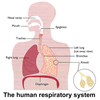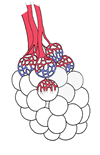|
Respiratory system
All living things require energy. Most cells obtain energy by the process
of cellular respiration which involves the reaction of oxygen with glucose
sugar to release energy, as well as carbon dioxide as a waste product.
(see Plant systems B: Photosynthesis,
nutrition and respiration).
The function of the respiratory system is to facilitate the intake
and absorption of oxygen, so that it is available to the cells for cellular
respiration in which energy will be released.
Worms absorb oxygen through their moist skin. Fish use their blood-rich
gill plates to absorb oxygen from the surrounding water.
 Large endothermic (warm-blooded) animals such as land-dwelling
humans breathe air (which is approximately 20% oxygen) through internal
specialised organs called lungs.
Large endothermic (warm-blooded) animals such as land-dwelling
humans breathe air (which is approximately 20% oxygen) through internal
specialised organs called lungs.
The lungs of humans are situated in the pleural cavity (chest area),
surrounded on the sides by the ribs and below by the diaphragm.
Airways
 Air entering the nose is warmed and foreign particles
filtered out of it by fine hairs called cilia. The air then passes through
the throat (pharynx). Food is prevented from entering the lungs by the
epiglottis, a flap of tissue that covers the windpipe during swallowing.
The trachea (windpipe) branches into two bronchi, one to each lung.
In the lung, each bronchus divides into increasingly smaller bronchioles
ending in lobed, thin-walled sacks called alveoli.
Air entering the nose is warmed and foreign particles
filtered out of it by fine hairs called cilia. The air then passes through
the throat (pharynx). Food is prevented from entering the lungs by the
epiglottis, a flap of tissue that covers the windpipe during swallowing.
The trachea (windpipe) branches into two bronchi, one to each lung.
In the lung, each bronchus divides into increasingly smaller bronchioles
ending in lobed, thin-walled sacks called alveoli.
 Each
alveolus has a capillary network covering it which provides an enormous
surface area for oxygen to enter the blood from the lungs and carbon
dioxide to leave. There are approximately 300 million alveoli in each
lung, with a combined surface area for exchange of about the size of
a tennis court. Each
alveolus has a capillary network covering it which provides an enormous
surface area for oxygen to enter the blood from the lungs and carbon
dioxide to leave. There are approximately 300 million alveoli in each
lung, with a combined surface area for exchange of about the size of
a tennis court.
The oxygen combines with the red pigment haemoglobin carried by the
red blood cells, while the carbon dioxide is carried in solution.
Breathing
When the muscles between the ribs (intercostals) contract along with
the diaphragm, the chest cavity enlarges in volume. This reduces the
air pressure in the lungs below that of the external atmosphere so air
is forced in from outside bringing in fresh oxygen (inspiration).
When the intercostals and the diaphragm relax, the chest volume decreases
and air is forced out removing waste carbon dioxide (expiration).
Control of breathing
Breathing is an involuntary action under the control of the respiratory
centre found in the base of the brain (medulla). The medulla sends rhythmic
impulses to the intercostal and diaphragm muscles to maintain breathing,
although we can temporarily over-ride this process voluntarily. The
medulla is sensitive to carbon dioxide levels in the blood, so the breathing
rate can be altered to accommodate varying needs during exercise or
rest.
|